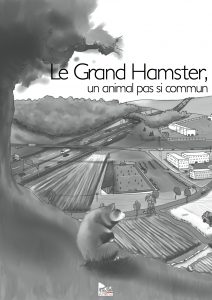The European Hamster is a protected hibernating rodent species. It looks a bit like the Golden Hamster that can be sometimes found in pet shops. It, however, cannot be tamed, being a solitary animal, afraid of humans. It spends 95% of its time in its underground burrow, only leaving it at dawn and nightfall.

This is a wild animal.
It prefers to dig its burrow in wheat or alfalfa fields. These fields allow it not only to feed, but to hide from predators. Leaving its burrow is always a moment fraught with danger for this rodent, who must take special care not to be seen by foxes, buzzards and other animals who would like to make it their midnight snack!
Predation is the main cause of mortality for Common Hamsters, especially during reproduction cycles and when it ends its 5 month hibernation cycle (from September to March).
The colour of its fur allows you to differentiate it from other types of hamsters.
Other types of hamsters generally have lighter coloured fur on their stomachs, whereas the European Hamster’s fur is black. Its back is a nice tone of reddish-brown, and it has white spots on its sides and on the end of its paws. It is also larger, almost as large as a Guinea Pig, leading to its name of “Large” or “European Hamster.”
Download the technical book (PDF, 6 Mb)
IDENTITY SHEET of the EUROPEAN HAMSTER
- Classification: Rodent mammal, from the rat and mice family
- Latin name: Cricetus cricetus
- Adult weight: 150 to 550 g
- Adult size: head + body 20 to 27 cm / tail: 3 to 6 cm.
- Life span: 1 to 2 years in a natural environment.
- Burrow: it is 1 to 2 metres deep with characteristic little mounds next to the entrance hole (diameter 5 to 9 cm).
Glossary
Muridae: Family of small rodents with a pointed nose, a long rounded tail, including rats, mice, field mice and hamsters.
Predation: The way of nutrition in the animal world where food consumed is composed of capturing a pre-determined prey.
Hibernation: To save energy during the winter months, some animals hibernate. They stop all their activities and “sleep” for several months.


